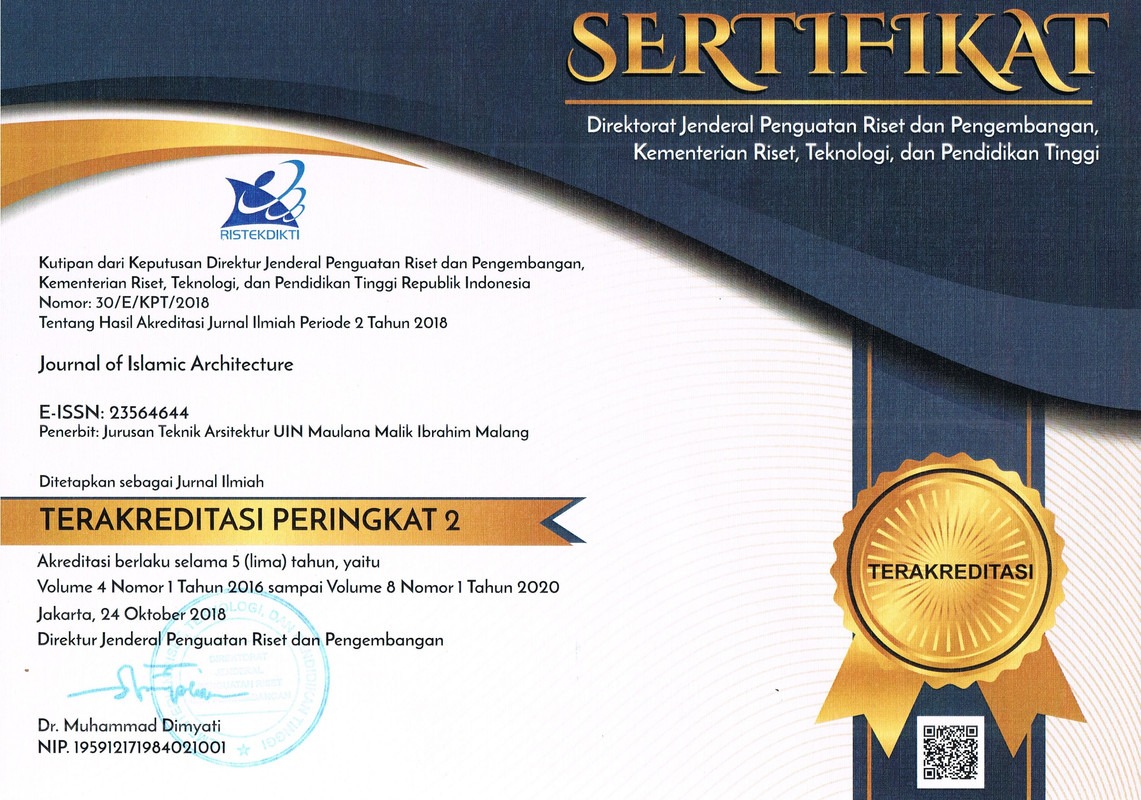A RESEARCH ON THE USE OF OTTOMAN-ISLAMIC HERITAGE AS A CONSUMPTION OBJECT IN CONTEMPORARY ARCHITECTURAL PRACTICE
Abstract
Keywords
Full Text:
PDFReferences
A. Colquhoun, Essays in Architectural Criticism. Ankara: Şevki Vanlı Mimarlık Vakfı, 2005.
T. Cansever, "İslam Mimarisi Üzerine Düşünceler", Divan: Disiplinler Arası Çalışmalar Dergisi, no.1, pp.119–146, 1996.
İ. Taşpınar, "Titus Burckhardt ve Mimaride Dini Sembolizm", Milel ve Nihal, no.14/2, pp.159-173, 2017.
T. Burckhardt, Art of Islam: Language And Meaning. Indiana: World Wisdom, 2009.
R. Hillenbrand, Islamic Art and Architecture. London: Thames and Hudson, 1999.
Ü. Alsaç, "Türk Mimarlık Düşüncesinin Cumhuriyet Devrindeki Evrimi", Mimarlık, no.11-12, pp.12-25, 1973.
A. Erarslan, "A Historicist Approach in The Development Process of Modern Turkish Housing: Sedad Hakkı Eldem’s Residential Structures", The Journal of International Social Research, no.13/71, pp.378-389, 2020.
D. Hasol, 20. Yüzyıl Türkiye Mimarlığı. İstanbul: YEM Yayınları, 2017.
B. Tanju ve U. Tanyeli, "Sedad Hakkı Eldem: Bir Katalog Denemesi", Sedad Hakkı Eldem II: Retrospektif. İstanbul: Osmanlı Bankası, pp.29-318, 2009.
C. Bektaş, Türk Evi. İstanbul: YEM Yayınları, 2013.
S. Bozdoğan, "Türk Mimari Kültüründe Modernizm: Genel Bir Bakış", Türkiye’de Modernleşme ve Ulusal Kimlik. İstanbul: Tarih Vakfı Yurt Yayınları, pp.333-383, 2005.
N. Bayazıt, "Safranbolu Evlerinin Plan Tipolojisi ve Kullanıcı İhtiyaçları Hiyerarşisi", Tasarım+ Kuram, no.10/17, pp.1-15, 2014.
M. Ergüler, Sedad Hakkı Eldem Binalarının Analizi, PhD diss., Istanbul, 1996.
H. Z. Yüksel, "Yeniyi Eskinin İçinden Çıkarmak" [Online]. Available: 10.10.2020 http://mimdap.org/2015/03/yeniyi-eskinin-ycinden-cykarmak-mimar-heval-zeliha-yuksel/
H. Yırtıcı, Çağdaş Kapitalizmin Mekânsal Örgütlenmesi. İstanbul: Bilgi Üniversitesi Yayınları, 2005.
M. Berman, Katı Olan Her Şey Buharlaşıyor. İstanbul: İletişim Yayınları, 2016.
D. Kuban, Türk ve İslâm Sanatı Üzerine Denemeler. İstanbul: Arkeoloji ve Sanat Yayınları, 1982.
A. Çaycı, İslam Mimarisinde Anlam ve Sembol. Konya: Palet Yayınları, 2017.
S. H. Nasr, İslam Sanatı ve Maneviyatı. İstanbul: İnsan Yayınları, 2017.
T. Sağlam, "İslam Mimarisinin Sembolik Anlatıları Üzerine Bir Deneme", International Journal of Interdisciplinary and Intercultural Art, no.5/10, pp.251-279, 2020.
Arkiv website. [Online]. Available: 10.10.2020 http://www.arkiv.com.tr
B. Üstün Et. Al., "A Desıgner In The Intersectıon Of Islamıc-Ottoman Archıtecture: The Archıtectural Concept Of Turgut Cansever (1920-2009)", Journal Of Islamic Architecture, no.5/4, pp.229-242, 2019.
G. Debord, Gösteri Toplumu. İstanbul: Ayrıntı Yayınları, 1996.
S. Karacan Et Al., "Tarihsel Süreç İçinde Konaklama Merkezleri Han Ve Kervansarayların Günümüzde İpekyolu Turizm Projesine Dönüşümü", Cyprus: 5. Doğu Akdeniz Turizm Sempozyumu, pp.1-36, 2016.
B. Oral, "Geleneksel Mimariye Öykünme Bağlamında Günümüz Safranbolu Sivil Mimarisi", İnsan ve İnsan, no.6/21, pp.597-631, 2019.
Hilton Garden Inn Safranbolu Hotel. [Online]. Available: 14.09.2020, https://www.hilton.com.tr/
Traditional Safranbolu Houses. [Online]. Available: 14.09.2020, https://www.safranboluevleri.net/
G. Necipoğlu Et Al., 15. ve 16.Yüzyıl'da Topkapı Sarayı: Mimari, Tören ve İktidar. İstanbul: Yapı Kredi Yayınları, 2007.
Topkapı Palace in Istanbul. [Online]. Available: 14.09.2020, https://islamansiklopedisi.org.tr/topkapi-sarayi
M. A. Aydın & C. Yılmaz, Antik Çağ'dan XXI. Yüzyıla Büyük İstanbul Tarihi (Vol.7). İstanbul: İBB Kültür AŞ., 2015.
Topkapı Palace Hotel in Antalya. [Online]. Available: 14.09.2020, https://www.swandorhotels.com/en/hotels/topkapi-palace/
Titanic Mardan Palace Hotel. [Online]. Available: 13.09.2020, http://www.vitracagdasmimarlikdizisi.com/
Maiden’s Tower and Kuleli Military High School. [Online]. Available: 14.09.2020, https://commons.wikimedia.org/
Titanic Mardan Palace Hotel. [Online]. Available: 14.09.2020, https://mardanpalace.titanic.com.tr/
M. T. Koltuk, Dünden Bugüne Tarihi İstanbul Çarşıları, İstanbul: Türkiye Turing ve Otomobil Kurumu, 2018.
Z. Richer, "Toward a Social Topography: Status as a Spatial Practice", Sociological Theory, no.33/4, pp.347-368, 2015.
İstanbul Hilltown Mall. [Online]. Available: 04.10.2020, https://www.chainpm.com
Arkitera website. [Online]. Available: 04.10.2020, https://www.arkitera.com
Traditional Amasya Settlement. [Online]. Available: 04.10.2020, https://www.e-kutuphane.web.tr/
Traditional Edirne Houses. [Online]. Available: 04.10.2020, https://www.kulturportali.gov.tr/
S. Başkan, ‘Geleneksel Doğu Karadeniz Evleri’, Erdem, no.52, pp.41-90, 2008.
DOI: https://doi.org/10.18860/jia.v6i4.11811
Refbacks
- There are currently no refbacks.







